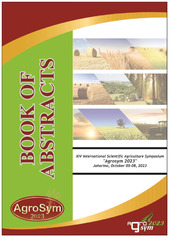Приказ основних података о документу
Stability of grain yield and oil content in early maturing soybean varieties
| dc.contributor | Kovačević, Dušan | |
| dc.contributor | BERJAN, SINISA | |
| dc.contributor | Rosanna, Quagliariello | |
| dc.creator | Peric, Vesna | |
| dc.creator | Simic, Marijana | |
| dc.creator | Nikolić, Valentina | |
| dc.creator | Tabaković, Marijenka | |
| dc.creator | Ristic, Danijela | |
| dc.creator | Kostadinović, Marija | |
| dc.creator | Mladenović Drinić, Snežana | |
| dc.date.accessioned | 2023-11-30T09:25:11Z | |
| dc.date.available | 2023-11-30T09:25:11Z | |
| dc.date.issued | 2023-10-08 | |
| dc.identifier.issn | 978-99976-987-7-3 | |
| dc.identifier.uri | http://rik.mrizp.rs/handle/123456789/1327 | |
| dc.description.abstract | The aim of this study was to examine the magnitude of genotype × environment (G × E) interaction for the grain yield and grain oil content in soybean genotypes from the collection of Maize Research Institute Zemun Polje and to identify stable sources for breeding for these traits. Fourteen soybean genotypes from maturity group 00 were tested in the field trials set up over two years, at two locations (Zemun Polje and Pancevo), according to a completely randomized block design. After harvest, the oil content in the grain was measured on a NIRT (near infra-red transmission) analyzer. Interaction G × E for grain yield and oil content was evaluated by the application of AMMI-1 (additive main effects and multiplicative interaction) model. A great portion of the variation (80.91%) of G × E interaction for the grain oil content in soybean genotypes was explained by the first interaction axis of the AMMI-1 model. Eight genotypes were distributed close to the stability line. The most important among them where two cultivars with above the average oil content and high stability, as well as the Agassiz variety, with a maximum average value of this parameter, expressing small interaction with environment. AMMI analysis for grain yield revealed that first interaction axis had explained 55.3% of the variation of G × E interaction for this trait. The largest number of genotypes achieved grain yield similar to the general average, with various interaction effects. The most stable grain yield was noted for Maple Presto variety, while the Olima, Evrika, PI 180507 and Kabott genotypes showed satisfactory stability. Cultivars Korana and Krajina proved to be superior to other genotypes, both in terms of yield and stability, confirming that domestic genotypes had adaptation to local agro-ecological conditions as compared to introduced ones. | sr |
| dc.language.iso | en | sr |
| dc.publisher | Banja Luka : University of Banja Luka, Faculty of Agriculture | sr |
| dc.relation | info:eu-repo/grantAgreement/MESTD/inst-2020/200040/RS// | sr |
| dc.rights | openAccess | sr |
| dc.rights.uri | https://creativecommons.org/licenses/by/4.0/ | |
| dc.source | 14. international scientific agriculture symposium “AGROSYM 2023" - Book of abstracts | sr |
| dc.subject | soybean | sr |
| dc.subject | seed yield | sr |
| dc.subject | oil content | sr |
| dc.subject | stability | sr |
| dc.subject | AMMI | sr |
| dc.title | Stability of grain yield and oil content in early maturing soybean varieties | sr |
| dc.type | article | sr |
| dc.rights.license | BY | sr |
| dc.citation.epage | 226 | |
| dc.identifier.fulltext | http://rik.mrizp.rs/bitstream/id/6676/bitstream_6676.pdf | |
| dc.identifier.rcub | https://hdl.handle.net/21.15107/rcub_rik_1327 | |
| dc.type.version | publishedVersion | sr |


